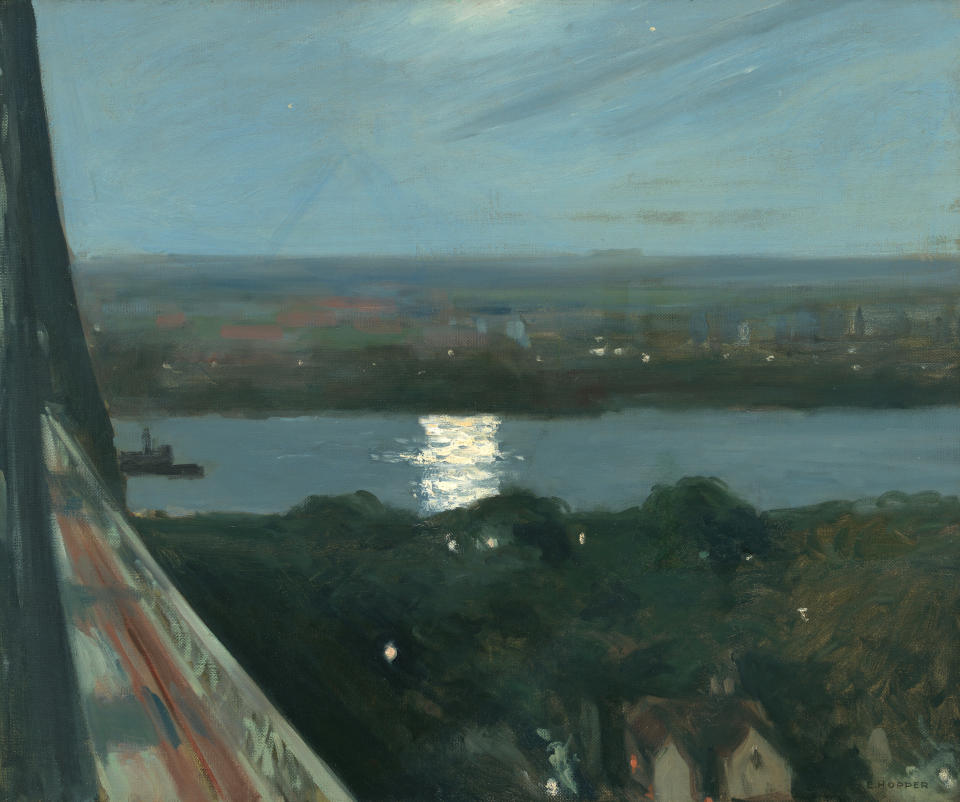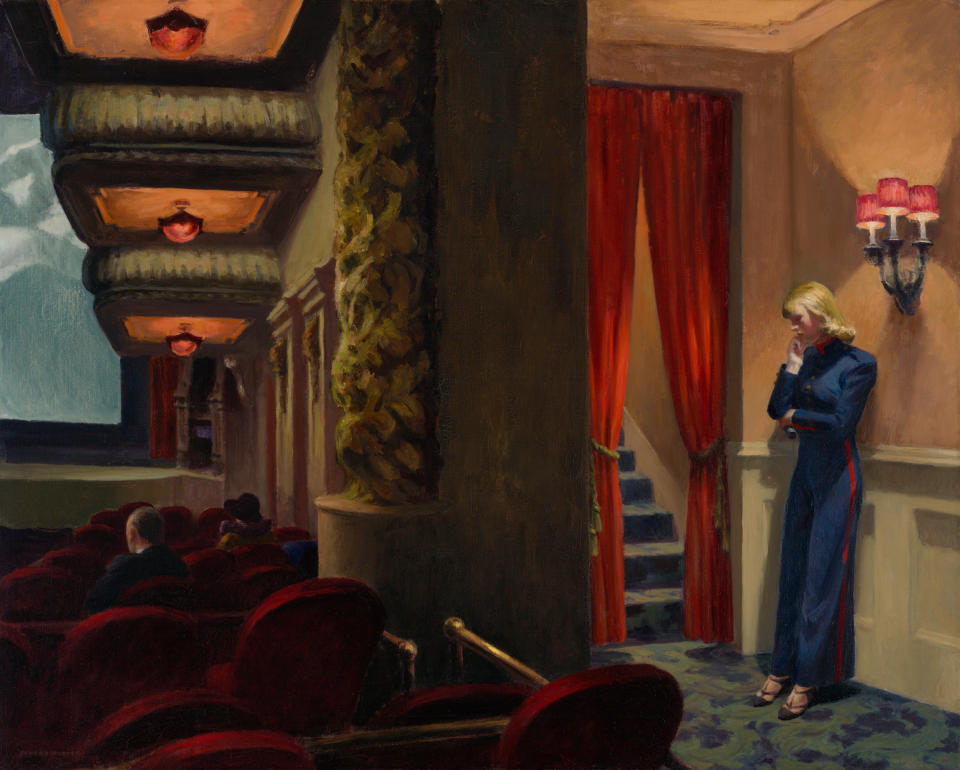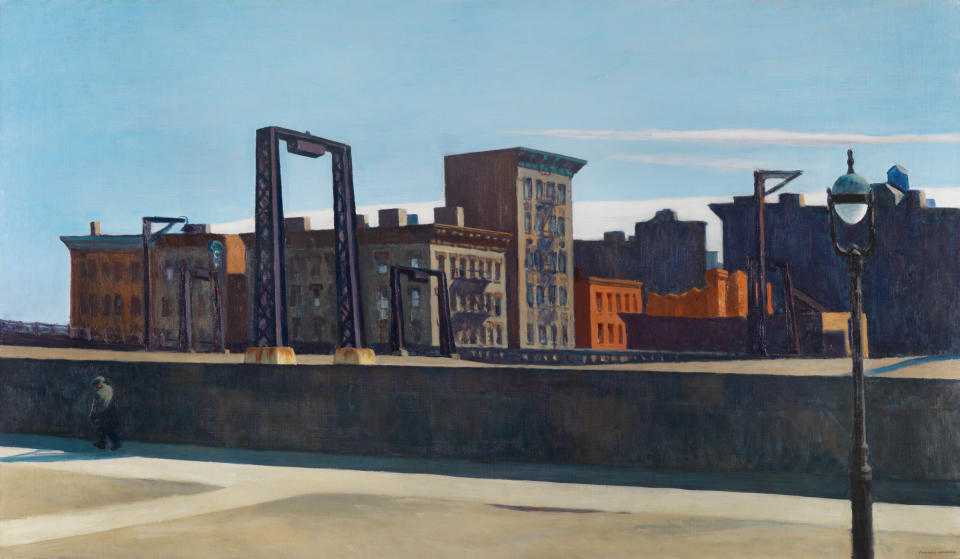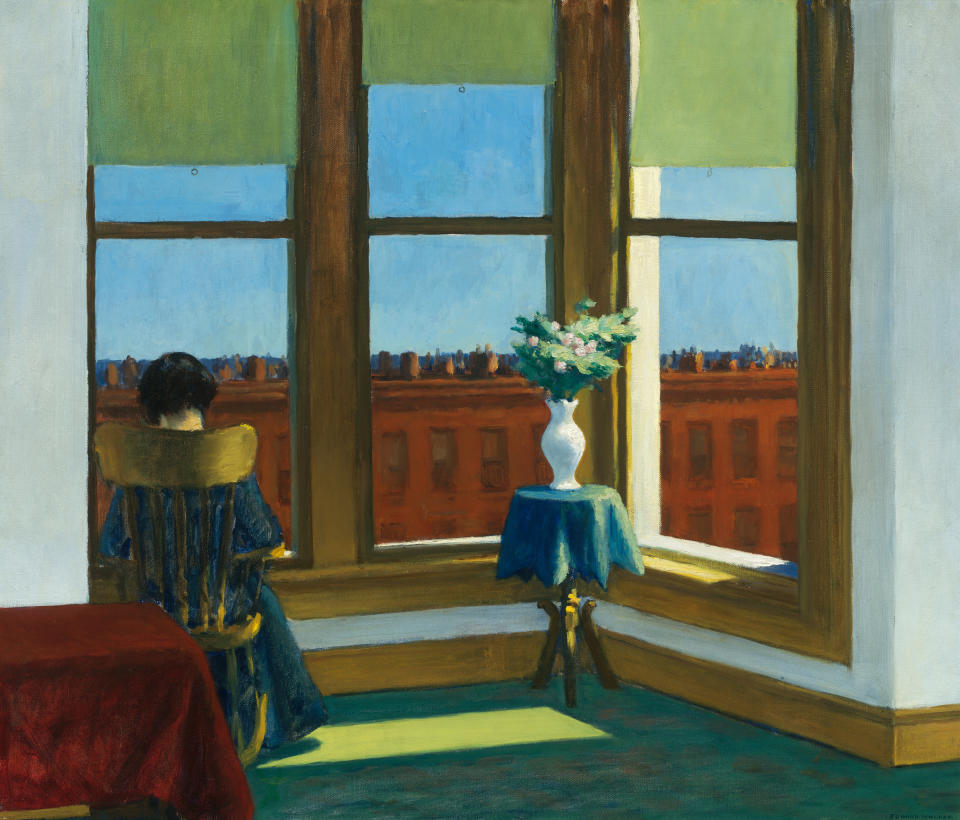Edward Hopper’s New York Can Still Be Seen Today
- Oops!Something went wrong.Please try again later.

Edward Hopper’s name alone can evince the lonesomeness of a woman in an empty diner at night or the ultra-ordinary stillness of a New York City Sunday morning, but The Whitney Museum of American Art presents the artist in more complexity in relation to the place that he called home for 60-plus years.
Walking through the expansive exhibition, there’s no denying the artist’s portrayals of solitary figures, pedestrian-free streets and nondescript apartment buildings from decades back. Such signs of quietude and emptiness may haunt some visitors as the world continues to try to yawn back to life from the pandemic, but any inclinations along these lines are said to be pure happenstance, considering that “Edward Hopper’s New York” was put in motion a few years before COVID-19 set in.
More from WWD
The just-opened exhibition will be on view until March 5.
The Whitney’s Kim Conaty, Steven and Ann Ames curator of drawings and prints, who curated the show with senior curatorial assistant Melinda Lang, says, “With an artist as iconic as Hopper, it can be hard to remember that he was also a human being and that he was living and working in a place that was actually this place over the course of decades.”
The Nyack, New York-born artist first visited the city on family outings as a child. After high school, he commuted by ferry to the New York School of Illustration and the New York School of Art, and later relocated to Greenwich Village, where he lived for most of his adult life until his death in 1967. An inveterate flaneur, the artist was known to canvas the city streets with sketchbook in hand.
The museum and the artist have a long history. In 1920, the 37-year-old Hopper has the first solo show at the Whitney Studio Club — and the Whitney Museum of American Art now has 3,100 of his works, more than any other museum globally.
Handwritten letters, illustrations, etchings, typed correspondence and other archival material is interspersed in some of the eight sections to magnify Hopper and his art. The “Washington Square” gallery, for example, features a letter penned by the artist to urban planner Robert Moses asking that his apartment building — a popular one for artists’ studios — be preserved, to illustrate how Hopper was an advocate for safeguarding downtown New York, especially Washington Square.
Collectively, the range of Hopper’s work is meant to “add new light to our understanding of him as a person, how he moved around the city, what he thought about the changes going on around him and what essential aspects of the city continued to capture his imagination and kept him looking again and again at the city around him,” Conaty says.

In the exhibition’s “Theater” gallery, there is a glassed case with 130 theater ticket stubs from performances that the Hoppers attended that are artistically arranged by individual colors. Hopper jotted down details about each production on the back of the tickets, providing a snapshot of the history of New York theater. Often seated in the rafters, those balcony seats provided more than an elevated view of the plays — Hopper also had a slightly elevated view in his paintings, Conaty notes. Interestingly, the rich Hopper color palette that includes hues like acidic green and a reddish orange are similar to some current fashion ones.

In fact, his Washington Square apartment, the site of the long-shuttered Nighthawks diner and other Hopper haunts, are within walking distance of the museum. To help cast his work in a new light and grasp a better understanding of him, the exhibition explores how he moved around the city, what he thought about the changes underfoot and what elements of New York captured his imagination.
“It’s exciting to imagine the streets that he strolled along, the rooftops he looked at from his own are the same ones that we are around today in this very neighborhood,” Conaty says.
Rather laconic and not interested in dissecting his work, Hopper’s dry humor and contrarian tendencies can be found in “Early Sunday Morning,” a painting of a “two-story, very ordinary stretched-out building in 1930, at the moment that every New York newspaper was writing about the race to the sky between the Chrysler Building and the Empire State Building,” she says.


Visitors are meant to not only get a fuller sense of who Hopper was, and his New York life, but also to mine a greater curiosity and appreciation for New York. As the title makes clear, the exhibition offers a very specific vision from one individual. But Conaty “likes to imagine that it could also be a prompt for all of us to look up from our phones a bit more, as we are walking along the sidewalk” and notice the city’s architecture or the “interior of someone’s apartment as you are passing it at night,” she says. “There are these little Hopper moments that can be easy to miss, when we have become increasingly absorbed by our own devices.”
The exhibition’s opening prompted a recent investigative piece by The New York Times that resurfaced questions of how Rev. Arthayer R. Sanborn, a neighbor of the Hopper family in Nyack, N.Y. and caregiver to first Hopper’s sister Marion later in life and then his wife, Josephine, came to amass a vast collection of Hopper personal items and notebooks that document Hopper’s life. Some of the few thousand items that Sanborn’s family donated to The Whitney are featured in the exhibition. The Whitney’s former Hopper curator Gail Levin has questioned how Sanborn wound up with those materials for years. There are reportedly no known records of any gifts of Hopper’s art to Sanborn nor did Hopper’s wife leave Sanborn any Hopper art in her will.
Asked for comment, a Whitney spokeswoman issued a statement, “The Whitney Museum is honored to be the home of Edward Hopper’s artwork, as the artist intended. The Whitney received nearly 3,000 pieces as a bequest from the Hopper estate through its executor The Bank of New York. The Whitney is confident that Hopper’s wishes were respected and met.”
The statement continued, “The museum is aware of claims made by a former curator. Those claims were considered when first made and were again researched more recently. The museum has found no basis to pursue the matter and is satisfied with what it received. The Whitney’s focus is on preserving the legacy and furthering the scholarship around the life and work of Edward Hopper, as it has done for over a century.”
Meanwhile, interest in Hopper’s childhood home in Nyack, N.Y., has steadily seen an uptick in visitors, “who are coming in with a purpose, but that didn’t happen just this week,” according to executive director Kathleen Motes Bennewitz. Nevertheless, the opening of The Whitney’s show and the recent release of the documentary “Hopper: An American Love Story,” have created “Hopperalooza.” she says.
Founded in 1971, the Edward Hopper House Museum and Study Center in Nyack, N.Y. was not part of the larger Sanborn family bequest in the late Sixties, but it does have gifts and loans from materials from the Reverend Arthayer R. Sanborn trust. “Anything that we have received whether in donations or even in stewardships of loans are done with due diligence and proper museum practices. That is what our standard has been. We became a museum officially chartered in the state of New York in 2017. Prior to that, the organization was the Edward Hopper Art Center.” Bennewitz says, adding that all of this occurred prior to her tenure a year ago she joined a year ago.
“We are very proud to be stewards of the Sanborn Hopper Family Archives. It’s an important body of work. It’s an asset and we have no basis or evidence to support any of the claims that have been made. We basically stand in the same light as The Whitney does on that point.” she says.
On the Hopper House site, visitors in search of Sanborn-Hopper Family Archive information are directed to a two-minute video from 2017 featuring the established art historian Richard Kendall. While arranging some archival material, Kendall said in the video “the son of a man that Hopper knew very well, Reverend Sanborn, is still alive and is very friendly towards the Hopper House. He still has some of his father’s collection, which though the process of discussion and negotiation and so forth is going to be on long-term loan to the Hopper House. He is very pro the Hopper House and supportive, and he wants it to be accessible to people, who are fascinated by Hopper. It’s a very big deal and its’s coming to us not all at once, but in sections, which is great news. It means we have time to catalogue them and preserve them, and of course make exhibitions around them. They are things that Hopper collected. Some of them are exercise books from high school, books he bought himself, and photographs and drawings as well. It’s the sort of thing that most kids have lying around in their bedrooms when they are growing up. In that sense, it’s very human and very touching. We feel that we are getting closer to him.”
Asked about the video, Bennewitz says, “Richard Kendall passed away last fall. I never met him. I don’t know if I have seen that video. He was never employed by the Edward Hopper House. If he offered any opinion, it was as a Nyack-based art historian. And he’s not alive like so many others to be able to ask – to inquire. I can’t comment on that opinion,” Bennewitz says, “I know he curated exhibitions there, but nothing that I was aware of that was on Hopper proper…some of the exhibitions that I am aware of that Richard worked on were in that capacity, not as a Hopper scholar. He was a [Edgar] Degas scholar.”
Separately, the Museum of Fine Arts in Boston disputed that a Hopper self-portrait was “fenced” by a friend of Sanborn’s to the museum in 1976. Director of communications Karen Frascona says, “We have reviewed the information offered by Gail Levin, and have determined that the allegations presented in the blog post are inconclusive. The provenance of “Self Portrait” by Edward Hopper is online and continues to reflect the best available information regarding the painting’s ownership history. We would welcome the opportunity to review any new details, should they come to light.”
While the controversy surrounding Hopper is not new, the Center for Art Law’s founder Irina Tarsis says the situation is a reminder to artists to think about their legacies ad how they want their art and work to be dispersed and treated, as well as to have their families protected to benefit from the assets that artists reap. She says, “Hopper is an important artist. It’s a very interesting selection and it’s good that it’s on display. But it is very important for artists to think about their legacy when they can so that situations like this can be avoided as best as possible. I am not sure if Hopper had a will. I understand his wife did. There was an executor for her estate. It is up to them to act, if they think there is some kind of inappropriate behavior.”
Although Tarsis has not yet seen the new show, she has read some of Levin’s research and describes it “as very interesting investigative work…her work is useful for us today, as well.”
Best of WWD
